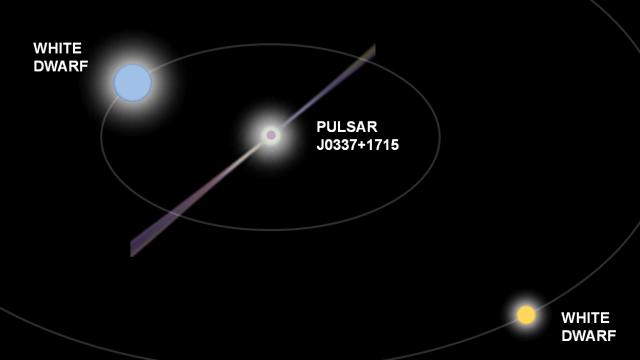Scientists understand gravity pretty well when it comes to two objects, but add a third, and you have chaos — a system that’s impossible to explain with our simplest equations. But you also have a way to test the limits of Einstein’s theory of gravity.
You’re probably aware of the fact that there are a lot of outstanding questions about our universe — such as what dark energy is, what dark matter is, and why one unified physics theory can’t explain both the biggest and smallest objects in the universe.
A recurring theme of experiments probing these problems is that they test Einstein’s theory of general relativity. You look at the extremes of the theory, hoping there are places where the real world doesn’t agree with it. But no matter what anyone does, the theory hasn’t failed yet.
“Testing general relativity is important right now,” Anne Archibald, a physicist from the University of Amsterdam, told Gizmodo. “We’re testing it in a way that’s been difficult up to now.”
The researchers are testing something called the equivalence principle. You can define mass in two ways: How an object behaves in a gravitational field, and how it behaves when you try to push on it, also called its inertial mass. General relativity says these are actually the same. If you were in space, accelerating upward in an elevator, the force your inertial mass feels could be precisely mimicked by the feeling of standing on a planet with the right gravity.
But are the two actually the same? Scientists have performed tests comparing the Earth, the Moon and the Sun, and a recent experiment even involved the planet Mercury. So far, Einstein’s theory hasn’t been proven wrong.
A new paper published in Nature instead uses observations of a three-body system called PSR J0337+1715. This system consists of a spinning neutron star shooting a beam of light (called a pulsar) and a white dwarf that orbit each other every 1.6 Earth days, both of which orbit another white dwarf every 327 Earth days.
They used 800 observations of the system spanning over six years, using the Westerbork Synthesis Radio Telescope in the Netherlands, the Robert C. Byrd Green Bank Telescope in West Virginia, and the William E. Gordon telescope at the Arecibo Observatory in Puerto Rico.
How would you test the equivalence principle? Well, you have two objects. One is a white dwarf star, whose mass is mostly composed of matter. Then there’s the pulsar.
The pulsar requires a lot of gravitational energy holding it together — and, by Einstein’ famous E=mc2 equation, the gravity makes the pulsar even heavier, because energy and mass are equivalent. In fact, a significant fraction of the pulsar’s mass, maybe 10 to 20 per cent, can come from the gravity holding it together.
If general relativity is wrong, then the neutron star would behave differently from its nearby white dwarf companion in reaction to the distant white dwarf’s gravity.
The researchers could measure this behaviour based on the pulsing behaviour of the spinning neutron star. The observations revealed that the white dwarf and the pulsar seemed to behave exactly the same way in response to the other white dwarf’s gravity. General relativity wins again.
Modelling three-body systems such as these is difficult. As Ingrid Stairs, study author and physicist from University of British Columbia, told Gizmodo, “When you have a third body, there there’s no neat solution that’s just an equation on a sheet of paper.”
You may have read the science fiction book, The Three Body Problem, which describes just how unpredictable these systems are through the lens of an alien species trying to survive on a planet orbiting one. Archibald was especially excited about the simulations she used to model the problem, using what she thought was rather basic physics.
These kinds of tests are important for the way they can rule out alternative theories of gravity that look like general relativity but differ for yet-to-be-explored physical realms.
One physicist not involved with the study, Clifford Will from the University of Florida, Gainesville, wrote that this research has made the validity of some of those alternate theories “much fainter” — but that they haven’t been completely ruled out, according to a Nature commentary. Deviations from general relativity would still have to be very small, said Archibald.
I also asked Archibald and Stairs whether they’d read The Three Body Problem by Liu Cixin. Stairs hadn’t, and Archibald is halfway through.
“One of the themes of the book is fundamental physics… if you do the same experiment in two places, physics doesn’t depend on where. It’s this universal fundamental physics you can get at with careful experimentation. [Liu] asks, what happens if physics doesn’t work that way?” she said. “I’m testing that at a fundamental level.”
[Nature]
